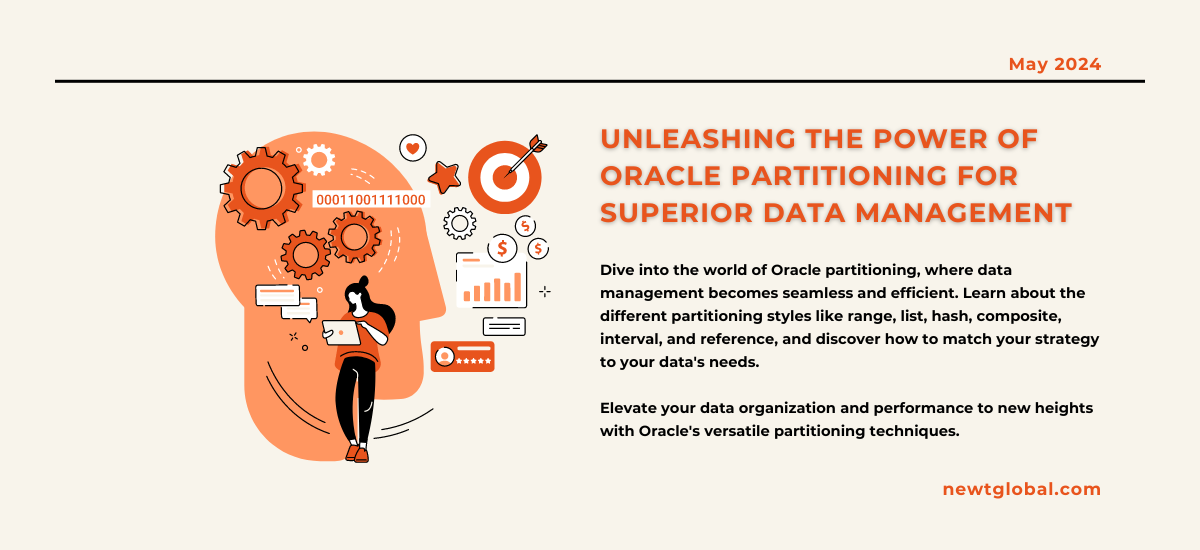
In the world of managing lots of data, Oracle is like a superhero. It gives you a bunch of cool tools that make handling and looking through your data much smoother and faster. One of the best tools it has is something called “partitioning.” This post is all about breaking down what Oracle partitions are, the different kinds you can use, and when you should use them.
The Essence of Partitioning
Think of partitioning like organizing a big room into smaller sections. You can divide tables or lists in a database into smaller parts, called partitions. Each partition acts like its own mini-table, making it easier to handle and go through your data. This makes things like looking up information, adding new data, or cleaning out old data much easier and quicker.
Spectrum of Oracle Partitions
Oracle lets you choose from several partitioning styles, each designed for different kinds of data and how you use it. Knowing these styles helps you get the most out of your database.
-
- Range Partitioning: This is great for data that falls into clear groups, like dates or numbers. It’s super helpful if you often need to look at specific time periods or sequences, making your searches fast and efficient, especially for historical data or scheduling.
- List Partitioning: Use this when your data fits into specific categories. It lets you assign certain data points to certain partitions. It’s like having dedicated bins for different types of products or places, making it really easy to find what you’re looking for.
- Hash Partitioning: This method spreads data evenly across all partitions using a special formula. It’s perfect when your data doesn’t naturally group into categories or sequences, helping you keep access times quick and consistent.
- Composite Partitioning: If you’re dealing with complex data and one type of partitioning isn’t enough, composite partitioning lets you mix and match methods for the best of all worlds. This way, you can manage your data even more precisely.
- Interval Partitioning: This is a smarter version of range partitioning. Oracle automatically creates new partitions for you at regular intervals. It’s ideal for data that keeps growing over time, like ongoing records or logs, reducing the work needed to keep things organized.
- Reference Partitioning: This type connects the dots between related data in different tables, aligning them in a way that makes sense. It’s particularly useful when you need to maintain strict relationships between data points, making managing and querying related data a breeze.
Strategy in Action
Your choice of partitioning should match how your data is shaped and how you use it. Here are some quick tips:
-
- Use range partitioning for linear, sequential data.
-
- Go for list partitioning when dealing with distinct categories.
-
- Pick hash partitioning to evenly spread out your data.
-
- Choose composite partitioning for complex situations needing a mix of methods.
-
- Opt for interval partitioning for data that grows regularly.
-
- Select reference partitioning when working with closely linked data.
Empowering Your Data Management
Oracle’s partitioning tool is like having a superpower for managing and using your data efficiently. By picking the right partitioning strategy, you can speed up searches, make data handling easier, and improve the overall performance of your database system. Dive into Oracle partitions and take your database from good to great.
Unlock the efficiency of Oracle’s partitioning feature with our comprehensive guide on high-speed data dynamics at Newt Global. Delve into the essence of partitioning and explore the spectrum of Oracle partitions, from range to reference.
Newt Global DMAP is a top-tier product designed to make the migration from Oracle Db to cloud-native PostgreSQL not just possible but faster, better, and more cost-effective. Whether you’re looking to enhance performance, cut costs, or just take advantage of the flexibility the cloud offers, Newt Global DMAP has got you covered.
Ready to transform your database management and unlock new levels of efficiency and scalability? Visit newtglobal.com to learn more about how Newt Global DMAP can streamline your migration process. And if you have any questions or need to get in touch with us directly, please don’t hesitate to reach out at marketing@newtglobalcorp.com.
